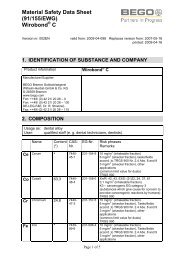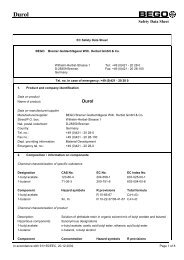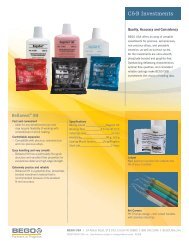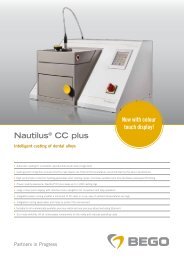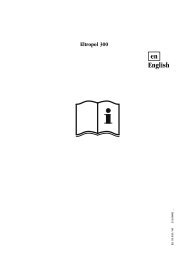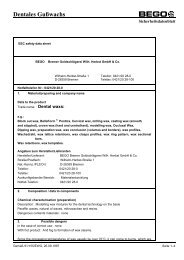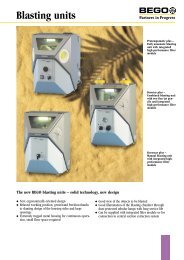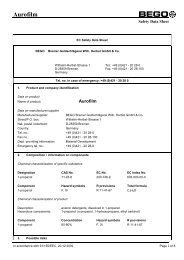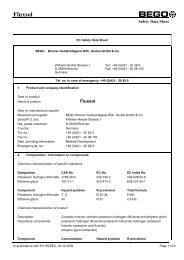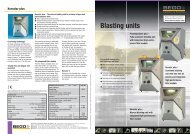Material Safety Data Sheet (91/155/EWG) Wirobond 280 - Bego USA
Material Safety Data Sheet (91/155/EWG) Wirobond 280 - Bego USA
Material Safety Data Sheet (91/155/EWG) Wirobond 280 - Bego USA
You also want an ePaper? Increase the reach of your titles
YUMPU automatically turns print PDFs into web optimized ePapers that Google loves.
<strong>Material</strong> <strong>Safety</strong> <strong>Data</strong> <strong>Sheet</strong><br />
(<strong>91</strong>/<strong>155</strong>/<strong>EWG</strong>)<br />
<strong>Wirobond</strong> ® <strong>280</strong><br />
Version nr: 001EN valid from: 2007-05-18 Replaces version from: 2007-02-02<br />
printed: 2007-08-01<br />
1. IDENTIFICATION OF SUBSTANCE AND COMPANY<br />
Product information <strong>Wirobond</strong> ® <strong>280</strong><br />
Manufacturer/Supplier:<br />
BEGO Bremer Goldschlaegerei<br />
Wilhelm-Herbst-GmbH & Co. KG<br />
D-28359 Bremen<br />
www.bego.com<br />
Fon: ++49/ (0) 42 1/ 20 28 – 0<br />
Fon: ++49/ (0) 42 1/ 20 28 – 130<br />
DE-LEG-F&E, Dr. R. Strietzel)<br />
Fax: ++49/ (0) 42 1/ 20 28 – 115<br />
2. COMPOSITION<br />
Usage as: dental alloy<br />
User:<br />
qualified staff (e. g. dental technicians, dentists)<br />
Name<br />
Content<br />
(*)<br />
CAS-<br />
Nr.<br />
EG-Nr.<br />
Risk phrases<br />
Remarks<br />
Co<br />
Cobalt 60,2 7440-<br />
48-4<br />
Cr Chromium 25 7440-<br />
47-3<br />
Ga Gallium 2,8 7440-<br />
55-3<br />
Mn Manganese * 7439-<br />
96-5<br />
Mo Molybdenum 4,8 7439-<br />
98-7<br />
231-158-0 Xn/R: 42, 43, 53/S: (2-)22, 24, 37, 61<br />
0,1 mg/m 3 (inhaleable fraction)<br />
K3 – cancerogenic EG-category 3<br />
(substances which give cause for concern to<br />
provoke cancerogenic reactions by humans)<br />
TRGS 900<br />
231-157-5 10 mg/m 3 (inhaleable fraction)<br />
6 mg/m 3 (alveolar fraction), Tasks/fields<br />
accord. to TRGS 900 Nr. 2.4 Abs. 8 and 9<br />
3 mg/m 3 (alveolar fraction), other<br />
applications<br />
(common limit value for dusts)<br />
TRGS 900<br />
231-163-8 10 mg/m 3 (inhaleable fraction)<br />
6 mg/m 3 (alveolar fraction), Tasks/fields<br />
accord. to TRGS 900 Nr. 2.4 Abs. 8 and 9<br />
3 mg/m 3 (alveolar fraction), other<br />
applications<br />
(common limit value for dusts)<br />
TRGS 900<br />
231-105-1 0,5 mg/m 3 (inhaleable fraction)<br />
TRGS 900<br />
231-107-2 10 mg/m 3 (inhaleable fraction)<br />
6 mg/m 3 (alveolar fraction), Tasks/fields<br />
accord. to TRGS 900 Nr. 2.4 Abs. 8 and 9<br />
Page 1 of 5
<strong>Material</strong> <strong>Safety</strong> <strong>Data</strong> <strong>Sheet</strong><br />
(<strong>91</strong>/<strong>155</strong>/<strong>EWG</strong>)<br />
<strong>Wirobond</strong> ® <strong>280</strong><br />
Version nr: 001EN valid from: 2007-05-18 Replaces version from: 2007-02-02<br />
printed: 2007-08-01<br />
Si Silicon * 7440-<br />
21-3<br />
W Tungsten 6,2 7440-<br />
33-7<br />
3 mg/m 3 (alveolar fraction), other<br />
applications<br />
(common limit value for dusts)<br />
TRGS 900<br />
215-609-9 10 mg/m 3 (inhaleable fraction)<br />
6 mg/m 3 (alveolar fraction), Tasks/fields<br />
accord. to TRGS 900 Nr. 2.4 Abs. 8 and 9<br />
3 mg/m 3 (alveolar fraction), other<br />
applications<br />
(common limit value for dusts)<br />
TRGS 900<br />
231-113-5 5 mg/m 3 (inhaleable fraction)<br />
TRGS 900<br />
* = contents less than 1 mass percent in <strong>Wirobond</strong> ® <strong>280</strong><br />
The given information are not valid for the alloy but only for vapours, smokes and<br />
dusts which may formed during the processing.<br />
3. HAZARD IDENTIFICATION<br />
By appropriate appliance and regarding the recommendations of the work hygiene it<br />
is improbable that <strong>Wirobond</strong> ® <strong>280</strong> exhibits a health risk.<br />
Due to the processing process dusts, fumes and smokes are emerged, which shall<br />
not be inhaled. Therefore sufficient exhaustion for dusts, fumes and smokes shall be<br />
used.<br />
In specific cases allergic reaction may occur.<br />
NFPA ratings for <strong>USA</strong> (scale 0-4)<br />
Health = 0<br />
Fire = 0<br />
Reactivity = 0<br />
HMIS rating<br />
Health = *0<br />
Fire = 0<br />
Reactivity = 0<br />
4. FIRST AID MEASURES<br />
If dusts, fumes or smokes were inhaled sufficient fresh air should be provided. If<br />
applicable a doctor should be consulted.<br />
In case of eye contact it should be rinsed thoroughly several minutes under running<br />
water. If applicable a doctor should be consulted.<br />
If swallowed a doctor should be consulted.<br />
Page 2 of 5
<strong>Material</strong> <strong>Safety</strong> <strong>Data</strong> <strong>Sheet</strong><br />
(<strong>91</strong>/<strong>155</strong>/<strong>EWG</strong>)<br />
<strong>Wirobond</strong> ® <strong>280</strong><br />
Version nr: 001EN valid from: 2007-05-18 Replaces version from: 2007-02-02<br />
printed: 2007-08-01<br />
5. FIRE FIGHTING MEASURES<br />
The material is inflammable and not oxidizing. In case of large quantities of dust the<br />
danger of dust an explosion is given.<br />
Toxic reaction products may occur by high temperatures.<br />
All extinguishing agents are suitable. Favourable are sodium chloride, dry sand<br />
6. ACCIDENTAL RELEASE MEASURES<br />
No personal precautions<br />
Contaminations should be picked up mechanically<br />
7. HANDLING AND STORAGE<br />
By appropriate application no special measures for handling or storage are<br />
necessary. Sufficient suction should be guaranteed.<br />
8. EXPOSURE CONTROLS AND PERSONAL PROTECTION<br />
Respiratory protection<br />
Eye protection<br />
Hand protection<br />
Ensure suitable suction<br />
If applicable use respirator (particle filter P3 according to<br />
DIN EN 143)<br />
If applicable use safety glasses<br />
If applicable use protective gloves (e. g. by known<br />
allergies against one or more alloy components)<br />
Working hygiene measures The usual safety precautions for working with chemical<br />
substances should be taken account of.<br />
During working to not eat, drink, smoke or snuff tobacco.<br />
Regard legal instructions for working hygiene<br />
Wash face and hands before break and/or end of work<br />
9. PHYSIAL AND CHEMICAL PROPERTIES<br />
Form - disk<br />
Colour - silver<br />
Odour<br />
odourless<br />
Melting interval °C 1360-140<br />
Inflammable - no<br />
Oxidizing properties - no<br />
Density g/cm³ 8,5<br />
Page 3 of 5
<strong>Material</strong> <strong>Safety</strong> <strong>Data</strong> <strong>Sheet</strong><br />
(<strong>91</strong>/<strong>155</strong>/<strong>EWG</strong>)<br />
<strong>Wirobond</strong> ® <strong>280</strong><br />
Version nr: 001EN valid from: 2007-05-18 Replaces version from: 2007-02-02<br />
printed: 2007-08-01<br />
10. STABILITY AND REACTIVITY<br />
In case of contact with acids the formation of hydrogen is possible.<br />
Dusts due to processing processes (e. g. casting, grinding) may cause in extreme<br />
cases dust explosions.<br />
11. TOXICOLOGICAL INFORMATION<br />
No dangerous reactions are known to occur with correct handling and storage.<br />
12. ECOLOGICAL INFORMATION<br />
Normally chemical substances, which accumulate as residual material, are special<br />
refuses. The removal is defined by legal waste management laws and corresponding<br />
regulations. In case of doubt contact the public authorities.<br />
Prevent penetration into soil, water and drainage systems.<br />
13. DISPOSAL CONSIDERATIONS<br />
Residual material should be recycled. Disposal according to local authority<br />
regulations<br />
Used packaging may also be disposed according to local authority regulations<br />
14. TRANSPORT INFORMATION<br />
Dental alloys are no hazardous materials in the sense of transport regulations<br />
(GGVS/GGV E/RID/ADR/IMDG-Code/ICAO-TI).<br />
15. Regulations<br />
Classification according to EU directives: according to preparation directive<br />
(1999/45/EG)<br />
No classification necessary<br />
Classification according to national directives:<br />
No classification necessary<br />
Page 4 of 5
<strong>Material</strong> <strong>Safety</strong> <strong>Data</strong> <strong>Sheet</strong><br />
(<strong>91</strong>/<strong>155</strong>/<strong>EWG</strong>)<br />
<strong>Wirobond</strong> ® <strong>280</strong><br />
Version nr: 001EN valid from: 2007-05-18 Replaces version from: 2007-02-02<br />
printed: 2007-08-01<br />
16. OTHER INFORMATION<br />
The information provided in this <strong>Material</strong> <strong>Safety</strong> <strong>Data</strong> <strong>Sheet</strong> (MSDS) is correct to the<br />
best of our knowledge, information and belief at the date of its publication. They<br />
describe the product in respect of safety recommendations. The given information do<br />
not cause a legal relation ship.<br />
The information given is designed only as guidance for safe handling, use,<br />
processing, storage, transportation, disposal and release and is not to be considered<br />
a warrant or quality specification. The information relates only to the specific material<br />
designated and may not be valid for such material used in combination with any other<br />
materials or in any process, unless specified in the text.<br />
The described product is to be used exclusively for the intended use (dental alloy).<br />
This version replaces all older issues.<br />
R 11<br />
R 12<br />
R 14<br />
R 15<br />
R 17<br />
R 40<br />
R 42<br />
R 43<br />
R 53<br />
easily inflammable<br />
highly inflammable<br />
Reacts intensivly with water.<br />
Reacts with water under formation of<br />
inflammable gases<br />
self inflammable at air<br />
Suspicion of cancerogenity<br />
Due to inhalation sensibilisation is possible<br />
Due to skin contact sensibilisation is possible<br />
May have long term effects on body water<br />
S 17<br />
S 22<br />
S 24<br />
S 37<br />
S 61<br />
Xn:<br />
Keep away from inflammable substances<br />
Do not inhale dust<br />
Avoid skin contact<br />
Use favourable protective gloves<br />
Avoid release in to the environment<br />
Hazardous<br />
Page 5 of 5



